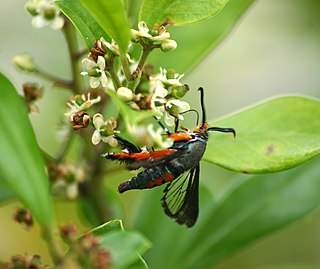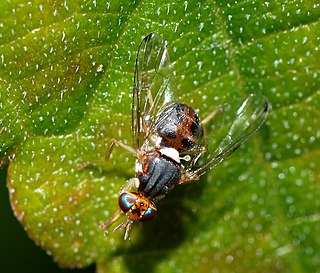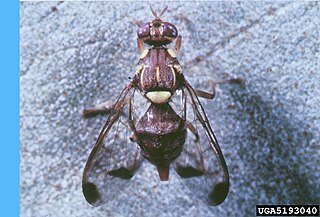
The squash vine borer is a diurnal species of sesiid moth. It is native to North America. The moth is often mistaken for a bee or wasp because of its movements, and the bright orange hind leg scales. The females typically lay their eggs at the base of leaf stalks, and the caterpillars develop and feed inside the stalk, eventually killing the leaf. They soon migrate to the main stem, and with enough feeding damage to the stem, the entire plant may die. For this reason, it is considered a pest that attacks cultivated varieties of squash, zucchini, pumpkin, and acorn squash. The squash vine borer is native to North America. It lives in most temperate North American states, except the Pacific coast. Southern states have two broods a year.

The Dacinae are a subfamily of the fruit fly family Tephritidae. Its 41 genera are distributed among three tribes:
Xanthomonas cucurbitae is a species of proteobacteria.

Amblyseius is a large genus of predatory mites belonging to the family Phytoseiidae. Many members of this genus feed on other mites such as red spider mites, and also on thrips. Several species are popular as biological control agents to control these pests.

The melon fly(Bactrocera cucurbitae) is a fruit fly of the family Tephritidae. It is a serious agricultural pest, particularly in Hawaii.

Henosepilachna sumbana, known commonly as the cucurbit ladybird, and sometimes listed as Henosepilachna cucurbitae is a pest ladybird species. H. sumbana feeds on cucurbits; vine-growing fruits such as melons, pumpkins, gourds, and cucumbers.
Amblyseius americanus is a species of mite in the family Phytoseiidae.
Amblyseius ampullosus is a species of mite in the family Phytoseiidae.
Amblyseius andersoni is a species of mite in the family Phytoseiidae. It is found in Europe.
Amblyseius animos is a species of mite in the Phytoseiidae family. It was described by A.S. Khan, M. Afzal and Shamshad Akbar in 2000, and is known from Pakistan.
Amblyseius bellatulus Tseng is a species of mite in the Phytoseiidae family that is native to Taiwan. It was described by Tseng Yi-Hsiung in 1983. Following his retirement, Tseng's collection of more than 20 holotypes of Taiwanese phytoseiid fauna were lost. A. Bellatulus re-described in 2017 by a team from National Taiwan University led by Liao Jhih-Rong, who collected new specimens of phytoseiid mites from the original locale used by Tseng as well as other areas throughout Taiwan.
Amblyseius neobernhardi is a species of mite in the family Phytoseiidae.
Amblyseius perlongisetus is a species of mite in the family Phytoseiidae.
Amblyseius serratus is a species of mite in the family Phytoseiidae.
Amblyseius similicaudalis is a species of mite in the family Phytoseiidae.

Amblyseius tamatavensis is a species of mite in the family Phytoseiidae.
Typhlodromips swirskii, the Swirski mite, is a species of predatory mite in the family Phytoseiidae. It is used in biological pest control of western flower thrips in greenhouse or indoor grown crops.





